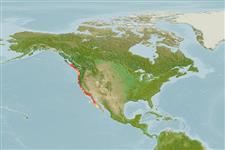Environment: milieu / climate zone / depth range / distribution range
Écologie
marin; saumâtre démersal; profondeur 0 - 425 m (Ref. 6793). Temperate; 52°N - 24°N, 131°W - 110°W
Eastern Pacific: Queen Charlotte Sound, British Columbia, Canada to Magdalena Bay, Baja California Sur, Mexico.
Length at first maturity / Taille / Poids / Âge
Maturity: Lm 32.0, range 29 - 39 cm
Max length : 56.0 cm TL mâle / non sexé; (Ref. 2850); poids max. publié: 1.5 kg (Ref. 40637); âge max. reporté: 35 années (Ref. 56049)
Épines dorsales (Total): 13; Rayons mous dorsaux (Total): 13-16; Épines anales 3; Rayons mous anaux: 7 - 9; Vertèbres: 26. Head spines very weak - preoculars present, nasal, supraocular and parietal spines usually absent, postocular, tympanic, coronal and nuchal spines absent; chin projects outward; preopercular spines fairly strong; anal fin small and rear edge slanted posteriorly, 2nd anal spine short; body slender (Ref. 27437). Caudal fin moderately indented (Ref. 6885). Pinkish red to copper pink, white ventrally; lateral line in bright red zone; caudal fin dusky (Ref. 27437).
Adults frequent deep rocky reefs as well as sand and mud bottoms; young are pelagic (Ref. 36715) and occur in shallower waters (Ref. 2850). Feed on euphausiids (Ref. 6885), krill, small squids and fishes (Ref. 2850). Viviparous, with planktonic larvae (Ref. 36715). Marketed fresh and frozen; eaten fried, boiled, microwaved and baked (Ref. 9988).
Eschmeyer, W.N., E.S. Herald and H. Hammann, 1983. A field guide to Pacific coast fishes of North America. Boston (MA, USA): Houghton Mifflin Company. xii+336 p. (Ref. 2850)
Statut dans la liste rouge de l'IUCN (Ref. 130435)
Menace pour l'homme
Harmless
Utilisations par l'homme
Pêcheries: commercial; pêche sportive: oui
Plus d'informations
RéférencesAquacultureProfil d'aquacultureSouchesGénétiqueElectrophoresesHéritabilitéPathologiesTraitementNutrientsMass conversion
CollaborateursImagesStamps, Coins Misc.SonsCiguateraVitesseType de nageSurface branchialeOtolithesCerveauxVision
Outils
Articles particuliers
Télécharger en XML
Sources Internet
Estimates based on models
Preferred temperature (Ref.
123201): 7 - 9.7, mean 8.2 °C (based on 39 cells).
Phylogenetic diversity index (Ref.
82804): PD
50 = 0.5000 [Uniqueness, from 0.5 = low to 2.0 = high].
Bayesian length-weight: a=0.01000 (0.00499 - 0.02004), b=3.09 (2.92 - 3.26), in cm total length, based on LWR estimates for this Genus-body shape (Ref.
93245).
Niveau trophique (Ref.
69278): 3.5 ±0.44 se; based on food items.
Résilience (Ref.
120179): Milieu, temps minimum de doublement de population : 1,4 à 4,4 années (K=0.24; tm=4; tmax=27; Fec=29,000).
Fishing Vulnerability (Ref.
59153): Moderate to high vulnerability (52 of 100).
Climate Vulnerability (Ref.
125649): Low to moderate vulnerability (27 of 100).
Nutrients (Ref.
124155): Calcium = 23.4 [8.5, 73.8] mg/100g; Iron = 0.242 [0.103, 0.603] mg/100g; Protein = 18.2 [16.9, 19.4] %; Omega3 = 1.34 [0.55, 3.24] g/100g; Selenium = 40.2 [14.5, 117.3] μg/100g; VitaminA = 18.4 [7.4, 48.4] μg/100g; Zinc = 0.429 [0.226, 0.756] mg/100g (wet weight);
